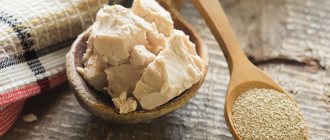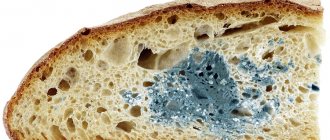An essential ingredient for making delicious baked goods is yeast. Thanks to them, the dough rises quickly, the bun turns out fluffy and soft. For retail sale, they are packaged in relatively small volumes, but even a briquette weighing 50 grams cannot always be used at a time. And the use of an expired product will affect the quality of the bread.
The shelf life of yeast varies from 1 day to 2-5 years. The specific figure depends on the type and characteristics of the product. Let's consider all the possibilities on how to store yeast and increase its shelf life.
Yeast storage conditions
It is recommended to store fresh yeast at +4°; for dry yeast, the optimal temperature is +15°.
The shelf life of different types varies greatly. For example, after opening the package, the ingredient begins to quickly deteriorate due to lack of moisture. Usually the manufacturer indicates storage conditions and periods on the packaging, so it is enough to follow the standard instructions. This is no more difficult than saving beets for the winter in an apartment.
Briefly about the varieties
Modern manufacturers produce a wide range of yeast, which differ in texture, consistency, smell, color, storage conditions and shelf life.
Bakery
These yeasts are “live” single-celled microorganisms (fungi), during the life of which carbon dioxide is released, which “raises” the dough.
There are several varieties of yeast product:
- Pressed - fresh, cream or light brown in color, packaged in small packs of 40-100 g (for consumers), or 0.5-1 kg (for bakeries). The high-quality pressed mass gives off a pleasant sour smell, does not stick to your hands, and when pressed does not smudge, but crumbles. The culture has a high degree of fermentation and requires dissolution in a warm liquid.
- Dry - available in the form of round or cylindrical granules, packaged in branded bags. This type is less demanding on conditions and storage location. Before use, dissolve in water and milk.
- Dry instant or instant - have an increased “lifting” ability, do not require activation, and are directly mixed into flour.
Do you know that…
Dry yeast contains not only the mushrooms themselves, but also various additives (minerals, enzymes) that enhance the activity of the culture.
You will learn which yeast to choose for baking, fresh or dry, from the video:
Other types
The following types of yeast are also distinguished:
- Alcohol - used in the production of alcoholic beverages, they carry out deep processing of the solution.
- Feed – biologically active, intended for feeding farm animals.
- Kombucha (medusomycete) is a symbiotic macroorganism consisting of acetic acid bacteria and yeast-like fungi. A mucous thick brownish-pink film requires a liquid nutrient medium (juices, tea), in which it will secrete the products of its vital activity.
How to preserve yeast at home
It is best to store yeast at home in the refrigerator. But if you don’t do everything according to the rules, the fungus may deteriorate earlier. To ensure that the delay does not affect the baked goods, it is recommended to test the product before use. It needs to be diluted with warm water and sugar. Within 15 minutes, bubbles will appear on the surface. The faster and more intensely this happens, the better the “activator” is preserved.
Bakery
After opening the package, baker's yeast will lose its properties within 24 hours at room temperature. In the refrigerator, the minimum “lifetime” is 4 days.
Pressed
Pressed yeast is packaged in bags of 50 and 100 grams; in regular stores you can find large portions of 0.5 and 1 kg. A small briquette is considered disposable and is completely consumed for 1 kg of flour. You can store compressed yeast at home for up to six months if you dry it first.
Dry
Disposable bags are available for sale.
The stick contains granulated powder weighing 11 grams, which is enough for 1 kg of flour. Whole packages are stored at room temperature for about 6 months. For fast-acting ones, the period increases to 2 years. But it’s better to leave the stick in a dark place where it stays at +15°. Similar conditions are suitable for unshelled walnuts. After opening, dry yeast granules are stored in the refrigerator at +4° for 4 to 6 weeks. The product must be kept in a closed container. For example, a glass jar with a lid will do.
Instructions:
- Crush the pressed briquette into crumbs.
- Stir in a little flour and salt.
- Leave to dry at room temperature for a day.
- Store in a glass jar covered with gauze for about 6 months.
Peculiarities of storing pressed yeast
Drying should be carried out in a well-ventilated area, away from strong-smelling products.
The fungus is stored in the refrigerator at +4°. The shelf life increases to 12 days if you wrap the briquette in foil. The top layer will darken during the process; before use, it is cut off and thrown away.
Alcohol
Alcohol and wine yeast are stored in sealed packaging at a temperature of +15°. It is recommended to leave the jar with them in the refrigerator. In this form, the product for making alcohol will last 2 years.
Beer “activators” are sold in liquid or semi-liquid consistency, so storage rules differ. They are diluted with water and left in the refrigerator at +4° - +9°. The water needs to be changed periodically; the fungus will retain its properties for 2 months.
What you need to know
First of all, you need to understand what yeast is. Any type of this substrate consists of living organisms (unicellular fungi). The mushrooms cause fermentation, which causes the dough to rise and become fluffy.
- For the alcoholic fermentation process to proceed normally, fungal organisms must remain active and viable. And you can create suitable conditions for them by observing the humidity level and temperature conditions.
- There is no substance in yeast that could prevent the evaporation of moisture. Therefore, they are stored at a humidity of 98%. In a drier place, the product loses up to 10% of its weight.
- All types of yeast are living microorganisms, so they need to “breathe”. For this reason, yeast should not be placed in vacuum bags before storing in the refrigerator.
- Each variety of this substrate has its own shelf life, which is usually indicated in the manufacturer’s recommendations on the packaging.
What yeast can be stored in the freezer?
Many people are interested in whether yeast can be frozen. Low temperatures do not lead to the death of the fungus; the active substance goes into suspended animation and retains its properties, so it can be stored in the freezer. The exception would be yeast for live beer.
Sourdough is also used to prepare sourdough and fluffy dough, but it cannot be stored in the freezer.
Instructions on how to freeze correctly:
- Package in single portions; for convenience, fresh ones are pressed into small cubes.
- Wrap each lobe in foil.
- Store for no more than 6 months.
The sticks sealed by the manufacturer will last in the freezer for 2 years. Some companies provide a guarantee of up to 5 years, but the activity of the product decreases over time, the dough is poor, and it is difficult to preserve the bread for a long time.
Pros of freezing:
- long shelf life;
- suitable for dry, pressed;
- convenient to use at home;
- There is no need to adjust the temperature in the freezer.
Minuses:
- must be packaged in single portions;
- pressed ones require defrosting;
- cannot be put back into the freezer.
Pressed
Most often you can buy compressed baker's yeast. If they are fresh and of high quality, their color will be soft - creamy, uniform. And their aroma has a slight sour tint. When lightly pressed, the product should crumble. But a good product cannot be sticky. It is mainly sold in bars of different sizes.
The question of how to store compressed yeast comes to every housewife immediately after purchasing it, and for good reason. After all, a fresh product is quite sensitive to the environment.
Shelf life
Storage of compressed yeast without refrigeration can last no longer than 24 hours. But you can increase their storage time by another 3 - 4 days. To do this, sprinkle a little salt on the block or treat it with flour.
Is it possible to use expired yeast?
Sometimes expired yeast is added when making alcoholic beverages: beer, wine, champagne. If the expiration date set by the manufacturer has expired, the properties of the product weaken.
You can’t add them to the dough, but you shouldn’t throw them away either.
The product is often used in cosmetology. There are many recipes for face masks containing yeast. This mask smoothes out facial wrinkles, refreshes the complexion and tightens the skin.
Physical properties of yeast
Yeasts are the simplest single-celled fungi. There are more than 1,500 species of them in the world. Some (pressed bakery, beer) benefit humans, others (candida genus) are opportunistic and can cause disease.
As far back as ancient Egypt, people used live yeast to ferment foods, bake and brew beer. But only in the 19th century did scientists realize that these were not just chemical compounds, but microorganisms capable of growth and reproduction.
Nowadays, compressed baker's yeast is most often used in households. For normal life they require the following conditions:
- Availability of oxygen. You should only store the product in packaging that "breathes". For example, in paper.
- Slightly acidic environment. The normal pH value is 4.5–5. During long-term storage in an alkaline environment (for example, in salt), yeast cells are inhibited.
- Optimal temperature. Most types of yeast, including baking yeast, cannot withstand 45–50 degrees. Therefore, there are no living microorganisms in finished baked goods, as authors in some media like to scare. But low temperatures are not a problem for yeast. The ideal option for fresh pressed ones is storage in the refrigerator.
So is it possible to freeze a “live” product? Yes. But only in compliance with the rules described below.
Can I use expired dry yeast?
After the expiration date, their “yeast” activity disappears. That is, the dough will not rise. If you eat a product made from such yeast, you will not get poisoned. But it is unlikely that you will be able to prepare fluffy and soft baked goods.
Interesting materials:
How to reset Meizu pattern key? How to reset Honor via computer? How to reset Instagram password via Facebook? How to reset parent password on Zala? How does a fitness bracelet count calories? How is the tax period calculated? How is the service life of a product calculated? How to count calories in dry or cooked porridge? How to count kcal of doshirak? How to calculate grades for a quarter in an electronic diary?
Can it be frozen?
Is it possible to store dry and fresh yeast in the freezer - after all, these are microorganisms? In principle, you can freeze any yeast, with the exception of brewer's yeast. Just remember that at temperatures below -2 °C the crop may die. On the other hand, freezing can significantly extend its shelf life.
To preserve the raw compressed product for up to 12 months, it can be placed in the freezer. For this:
- Divide it into small, easy-to-defrost pieces.
- Wrap each briquette in cling film, parchment or foil and put it in the freezer.
- Thaw in batches as needed at room temperature until soft.
You can also do this with unused dry yeast. Namely, package them in small sealed packages and place them in the freezer.
Before kneading the dough, make sure that the thawed yeast is active. To do this, dilute a little in 100 g of warm milk or water, add a spoonful of sugar and flour, let it brew for 10-15 minutes. If the mixture begins to bubble and foam, then the culture is alive.
Following simple “tricks” will help to preserve for a long time the biological component that is important for delicious baked goods. Of course, the best option is to purchase a “live” product as needed and in small quantities, because stale and expired yeast will not rise the dough, and baking will not work.
Source
Storage recommendations
Living yeast substrate is capable of absorbing foreign odors, so it is not recommended to store it next to food products that have a pronounced aroma. Yeast exposed to reduced temperatures does not always maintain its original characteristics, and because of this, it is necessary to monitor its condition. You can check their quality as follows:
- Milk, 200 ml in volume, needs to be heated to +30...+40̊ C, and then add about 1 tsp to the liquid. sugar (it is acceptable to use flour in the same amount).
- The top layer of yeast is removed and added to the heated liquid, dissolving in it.
- When foam appears on the surface of the liquid after 10-15 minutes, this indicates that the yeast substrate is alive.
If there is no reaction, then such yeast has already lost its own qualities and storing it further is useless; such a product must be thrown away.











